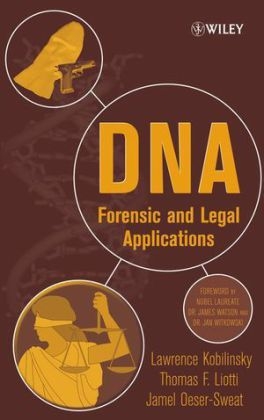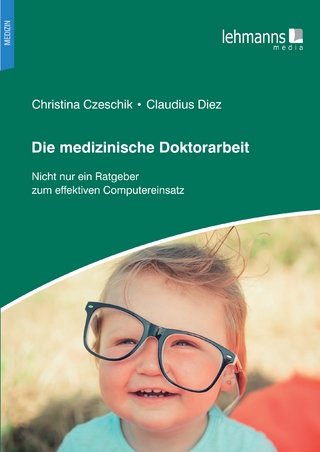
DNA
Wiley-Interscience (Verlag)
978-0-471-41478-0 (ISBN)
Includes a Foreword by Dr. James D. Watson, the co-discoverer of the DNA double helix, and Dr. Jan A. Witkowski.
"From the Foreword by Drs. Watson and Witkowski: 'DNA: Forensic and Legal Applications is a comprehensive and invaluable guide to the field, covering topics ranging from collecting samples in the field to presenting the complex results to a jury. We are sure that it will play its part in promoting this most powerful tool in the forensic scientist's armamentarium.'"
DNA: Forensic and Legal Applications covers the technology and laws related to DNA, as well as the use of DNA evidence in the legal system. This combination of science and law makes it the first comprehensive title of its kind and an appropriate reference for those with both elementary and advanced knowledge of the topic. It draws together in one source information that would previously have required extensive research and reliance on experts to obtain, offering both breadth and depth in a clear style without s acrificing scholarly goals.
With material from both scientific and legal areas, DNA: Forensic and Legal Applications covers the latest advances in technology. It provides an ideal text for forensic scientists and students of forensic science, analytical chemists, lawyers, judges, police officers, and detectives.
LAWRENCE KOBILINSKY is currently the Associate Provost and a Professor of Biology and Immunology at John Jay College of Criminal Justice. An internationally renowned forensic scientist, he is a Fellow of the American Academy of Forensic Sciences as well as the New York Microscopical Society, and has published extensively in the areas of identification and individualization using protein genetic markers and DNA analysis. THOMAS F. LIOTTI has represented clients in high-profile cases involving DNA. He is a Village Justice in Westbury, New York, and is currently a partner at the law offices of Thomas F. Liotti, located in Garden City, New York. He is a past president of the New York State Association of Criminal Defense Lawyers and Fellow in the American Board of Criminal Lawyers. JAMEL OESER-SWEAT is a member of both the New York and New Jersey bars and has been admitted to practice before the Patent and Trademark Office. A former Westinghouse scholar, he has published several abstracts and articles in the field of microbiology, and has been a guest lecturer at several universities and conferences.
Foreword. Preface.
Acknowledgements.
1. Biochemistry, Genetics, and Replication of DNA.
1.1 Evolution of Identification: From Faces to Fingerprints to DNA.
1.2 DNA and Heredity.
1.2.1 A Look at DNA from the Outside In.
1.2.2 DNA—The Chemistry.
1.2.3 Unique Sequence and Repetitious DNA.
1.3 DNA Replication.
1.3.1 Replication in the Cell.
1.3.2 Cloning (Gene Amplification).
2. Biological Evidence—Science and Criminal Investigation.
2.1 Crime Scene Investigation—Biological Evidence.
2.1.1 Help the Victim.
2.1.2 Protect the Scene.
2.1.3 Document the Scene.
2.1.4 Search the Scene.
2.1.5 Schematic Drawing Showing Location and Photography of Items of Evidence.
2.1.6 Packaging and Preserving Evidence.
2.1.7 Transport to Laboratory.
2.1.8 Sexual Assault Evidence.
2.1.9 Evidence Handling in the Laboratory.
2.1.10 Report Writing.
2.2 Serology.
2.2.1 Blood.
2.2.2 Semen.
2.2.3 Saliva.
2.2.4 Urine.
2.2.5 Hair.
2.3 Chain of Custody.
3. Forensic DNA Analysis Methods.
3.1 Associative Evidence and Polymorphism.
3.2 Restriction Fragment-Length Polymorphism.
3.2.1 Isolation of DNA.
3.2.2 Quantification.
3.2.3 Restriction Enzymes: DNA Scissors.
3.2.4 Gel Electrophoresis.
3.2.5 Southern Blotting.
3.2.6 Hybridization.
3.2.7 Autoradiography and Visualization of DNA Banding Pattern.
3.2.8 Analysis of RFLP Results.
3.2.9 Probe Stripping from Membrane.
3.2.10 Match Criteria.
3.2.11 Statistics and the Product Rule.
3.3 Polymerase Chain Reaction.
3.3.1 Development and Theory.
3.3.2 Isolation of DNA.
3.3.3 Quantification
3.3.4 Techniques.
3.4 Analysis of Y-Chromosome STRS.
3.4.1 Y-Chromosome Single-Nucleotide Polymorphism Analysis.
3.5 Analysis of Mitochondrial DNA.
3.5.1 The Mitochondrial Genome.
3.5.2 Quantification.
3.5.3 Sequencing.
3.5.4 Interpretation of Sequence Data.
3.5.5 Heteroplasmy.
3.5.6 Statistics.
3.5.7 SNP Analysis of Mitochondrial DNA.
3.6 Problems with PCR.
3.6.1 Contamination.
3.6.2 Degradation.
3.6.3 Sunlight.
3.6.4 Inhibitors.
3.6.5 Allelic Dropout—Null Alleles.
3.6.6 Human Error.
3.7 Underlying Facts and Assumptions in Forensic DNA Testing.
4. Genetics, Statistics, and Databases.
4.1 Human Genetics, Population Genetics, and Statistics.
4.1.1 Power of Forensic DNA Analysis: How Significant Is the Match?
4.1.2 Genetics and Statistics.
4.1.3 Mendel’s Laws of Genetics.
4.1.4 Meiosis.
4.2 Population Genetics.
4.2.1 Hardy–Weinberg Equilibrium.
4.2.2 Subpopulations and Substructure.
4.3 Need for Quality Control and Quality Assurance.
4.4 SWGDAM (Formerly Known as TWGDAM) Standards.
4.5 DNA Advisory Board.
4.6 Mitochondrial DNA and Y-Chromosome STR Analysis and Statistical Calculations.
4.7 Experimental Controls.
4.8 Validation of New DNA Methods.
4.9 Single-Nucleotide Polymorphism Analysis.
4.10 Database Size and Composition.
4.11 DNA Databases.
4.12 Power of Discrimination.
4.13 Mixtures and Statistics.
4.14 Probability of Exclusion.
4.15 Likelihood Ratio (LR).
4.16 Paternity Determinations.
4.16.1 Exclusion of the Alleged Father as the Biological Father.
4.16.2 Inclusion of the Alleged Father as the Biological Father.
4.17 Lab Accreditation, Certification, Reputation, and Facilities.
4.17.1 Quality Control.
4.17.2 Quality Assurance.
4.17.3 Proficiency Testing.
4.17.4 Certification.
4.17.5 Laboratory Accreditation.
4.18 Reviewing a DNA Report—A Sample RFLP Analysis.
4.19 Reviewing a DNA Report—A PCR-Based DNA Examination (HLADQA1, PM, D1S80, and CTT-CSF1PO, TPOX, THO1).
4.20 Reviewing a DNA Report—A PCR-STR-Based DNA Examination (CODIS Loci).
4.21 Reviewing a Paternity Report Based on Analysis of DNA.
5. Litigating a DNA Case.
5.1 Legal Theory.
5.1.1 Admissibility of Scientific Evidence: A Primer.
5.1.2 Common Law and The Creation of a Judicial Gatekeeping Function.
5.1.3 Federal Rules of Evidence and the Expansion of the Judicial Gatekeeping Function.
5.1.4 Daubert: The Supreme Court Sets Forth a Standard.
5.1.5 General Electric Company et al. v. Joiner et ux.
5.1.6 Kumho Tire: The Court Continues Its Expansion of the Judicial Gatekeeping Function.
5.1.7 Judicial Gatekeeping Function and Its Evolution in New York State.
5.2 Admissibility of DNA Evidence.
5.2.1 PCR-STR DNA Evidence.
5.2.2 Mitochondrial DNA.
5.2.3 Animal DNA.
5.2.4 Plant and Viral DNA.
5.2.5 Statistics.
5.2.6 Paternity.
5.3 Legal Practice.
5.3.1 Different Stages of a Trial.
5.4 DNA for Defense Attorneys—Contesting DNA Evidence.
5.5 DNA for Prosecutors.
5.6 DNA for Judges.
6. DNA Evidence at Trial.
6.1 Attacking and Defending DNA Evidence.
6.1.1 Theory of the Case/Plan of Attack.
6.1.2 What is Required for DNA Test Results to be Admitted into Evidence?
6.2 DNA for the Prosecutor or Those Who Seek to Admit DNA Evidence.
6.2.1 Effective Admission of DNA Evidence Takes Place in Three Stages.
6.3 DNA for the Defense or Those Who Seek to Mitigate the Effect of DNA Evidence.
6.3.1 Preventing the Admission of DNA Evidence in Part or in Its Entirety.
7. Exonerating the Innocent through DNA.
7.1 Postconviction Appeals Based upon DNA Evidence.
7.2 Postconviction DNA Testing: Recommendations for Handling Requests.
7.2.1 Role and Response of the Prosecutor.
7.2.2 Role and Response of the Defense Attorney.
7.3 Legal Standards Governing Postconviction Testing.
7.3.1 Argument for a Constitutional Right to Postconviction DNA Testing.
7.3.2 Other Non-Postconviction Testing Statute Arguments.
7.4 Postconviction DNA Testing Statutes.
7.5 Preventing Postconviction DNA Testing through Waiver.
7.6 The Future of DNA Technology.
Appendix A: Bibliography: Selected by Topic Area.
Appendix B: Cases Involving the Admissibility of DNA Evidence.
Appendix C: Information Pertinent to Attempts to Overturn Convictions Based Upon DNA Evidence.
Appendix D: Offenses in New York State Resulting in Mandatory DNA Testing for Database Inclusion.
Appendix E: Postconviction DNA Testing, Preservation of Evidence and Compensation for Wrongful Convictions: Relevant Legislative Information.
Appendix F: Items Obtained through Discovery.
Appendix G: Glossary.
Index.
| Erscheint lt. Verlag | 29.10.2004 |
|---|---|
| Vorwort | James D. Watson, Jan A. Witkowski |
| Sprache | englisch |
| Maße | 160 x 241 mm |
| Gewicht | 717 g |
| Einbandart | gebunden |
| Themenwelt | Informatik ► Weitere Themen ► Bioinformatik |
| Naturwissenschaften ► Biologie ► Genetik / Molekularbiologie | |
| Naturwissenschaften ► Chemie | |
| Recht / Steuern ► Allgemeines / Lexika | |
| Recht / Steuern ► EU / Internationales Recht | |
| Recht / Steuern ► Strafrecht ► Kriminologie | |
| ISBN-10 | 0-471-41478-6 / 0471414786 |
| ISBN-13 | 978-0-471-41478-0 / 9780471414780 |
| Zustand | Neuware |
| Haben Sie eine Frage zum Produkt? |
aus dem Bereich


